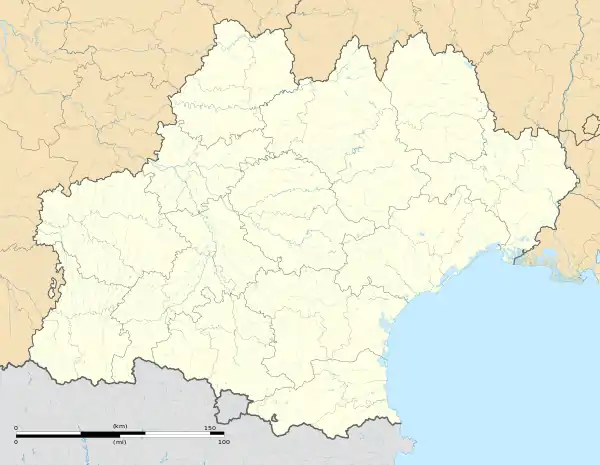Avène
Avène (Languedocien: Avèna) is a commune in the Hérault department in the Occitanie region in southern France.

Avène | |
|---|---|
 Church St-Andre-Rieussec | |
.svg.png.webp) Coat of arms | |
Location of Avène 
| |
 Avène  Avène | |
| Coordinates: 43°45′29″N 3°06′00″E | |
| Country | France |
| Region | Occitanie |
| Department | Hérault |
| Arrondissement | Béziers |
| Canton | Clermont-l'Hérault |
| Intercommunality | Grand Orb |
| Government | |
| • Mayor (2020–2026) | Serge Castan |
| Area 1 | 62.65 km2 (24.19 sq mi) |
| Population (2017-01-01)[1] | 287 |
| • Density | 4.6/km2 (12/sq mi) |
| Time zone | UTC+01:00 (CET) |
| • Summer (DST) | UTC+02:00 (CEST) |
| INSEE/Postal code | 34019 /34260 |
| Elevation | 294–978 m (965–3,209 ft) (avg. 330 m or 1,080 ft) |
| 1 French Land Register data, which excludes lakes, ponds, glaciers > 1 km2 (0.386 sq mi or 247 acres) and river estuaries. | |
Population
| Year | Pop. | ±% |
|---|---|---|
| 1962 | 332 | — |
| 1968 | 457 | +37.7% |
| 1975 | 430 | −5.9% |
| 1982 | 259 | −39.8% |
| 1990 | 269 | +3.9% |
| 1999 | 275 | +2.2% |
| 2008 | 293 | +6.5% |
| 2014 | 299 | +2.0% |
Avène Thermal Spring Water
A Hydrotherapy Centre was built near the Sainte-Odile spring in 1743 , and focuses on using the purported therapeutic properties of Avène Thermal Spring Water to address a variety of dermatological conditions and skin concerns such as atopic dermatitis, psoriasis, eczema and burns.
The brand is centered on Avène Thermal spring water. Precipitation filters through the Cévennes Mountains and resurfaces at the Sainte-Odile spring. Its composition is thought to make it effective for the care and management of sensitive skin. Over 150 stringent biological, pharmacological and clinical studies on Avène Thermal Spring Water have been conducted by the Avene Thermal Spring Company and independent researchers.
Sights

- Roman church ofe Saint-André-de-Rieussec 13th century.
- Church of Saint-Pierre de Rouvignac 12th century.
- Church of Sainte-Marie de Vinas 12th century.
- Church of Saint-Antoine de Serviès (1715).
- Saint-Barthélémy Church (1135).
- Truscas Church 19th century.
- Saint-Martin d'Avène church (modern).
- 13th century bridge over the Orb.
See also
References
- "Populations légales 2017". INSEE. Retrieved 6 January 2020.
| Wikimedia Commons has media related to Avène. |